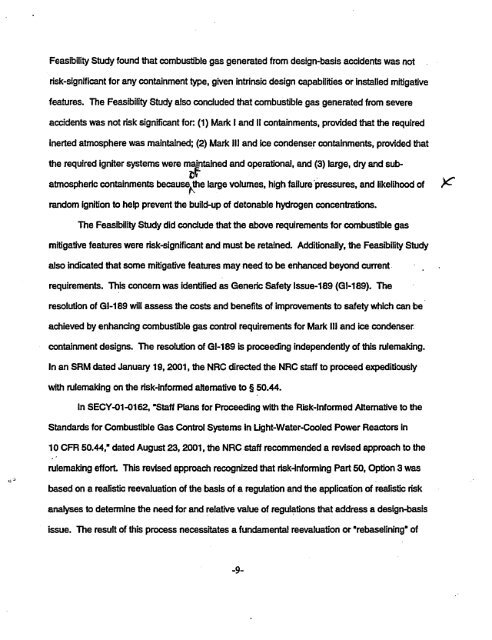SECY-03-0127 - NRC
SECY-03-0127 - NRC
SECY-03-0127 - NRC
Create successful ePaper yourself
Turn your PDF publications into a flip-book with our unique Google optimized e-Paper software.
Feasibility Study found that combustible gas generated from design-basis accidents was not<br />
risk-significant for any containment type, given intrinsic design capabilities or Installed mitigative<br />
features. The Feasibility Study also concluded that combustible gas generated from severe<br />
accidents was not risk significant for: (1) Mark I and I containments, provided that the required<br />
inerted atmosphere was maintained; (2) Mark IlIl and ice condenser containments, provided that<br />
the required igniter systems were maintained and operational, and (3) large, dry and sub-<br />
atmospheric containments because the large volumes, high failure pressures, and likelihood of<br />
random gnition to help prevent the build-up of detonable hydrogen concentrations.<br />
The Feasibility Study did conclude that the above requirements for combustible gas<br />
mitigative features were risk-significant and must be retained. Additionally, the Feasibility Study<br />
also indicated that some mitigative features may need to be enhanced beyond current<br />
requirements. This concern was identified as Generic Safety Issue-189 (GI-189). The<br />
resolution of GI-189 will assess the costs and benefits of improvements to safety which can be<br />
achieved by enhancing combustible gas control requirements for Mark IlIl and ice condenser<br />
containment designs. The resolution of GI-189 is proceeding independently of this rulemaking.<br />
In an SRM dated January 19, 2001, the <strong>NRC</strong> directed the <strong>NRC</strong> staff to proceed expeditiously<br />
with rulemaking on the risk-informed alternative to § 50.44.<br />
In <strong>SECY</strong>-01-01 62, Staff Plans for Proceeding with the Risk-informed Alternative to the<br />
Standards for Combustible Gas Control Systems in Light-Water-Cooled Power Reactors in<br />
10 CFR 50.44,0 dated August 23, 2001, the <strong>NRC</strong> staff recommended a revised approach to the<br />
rulemaking effort. This revised approach recognized that risk-Informing Part 50, Option 3 was<br />
based on a realistic reevaluation of the basis of a regulation and the application of realistic risk<br />
analyses to determine the need for and relative value of regulations that address a design-basis<br />
issue. The result of this process necessitates a fundamental reevaluation or rebaselining of<br />
-9-
















